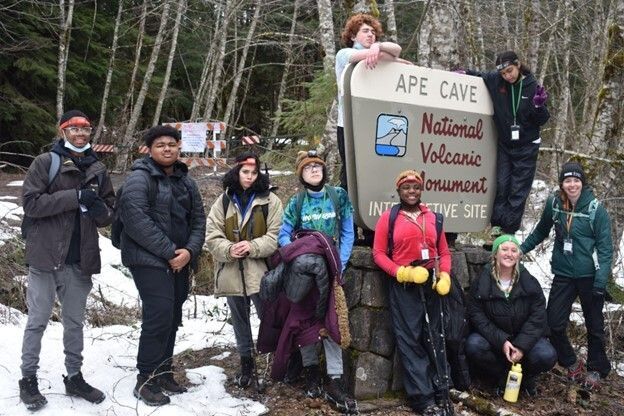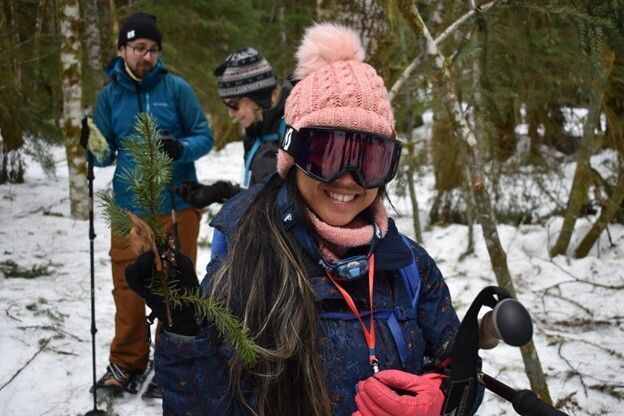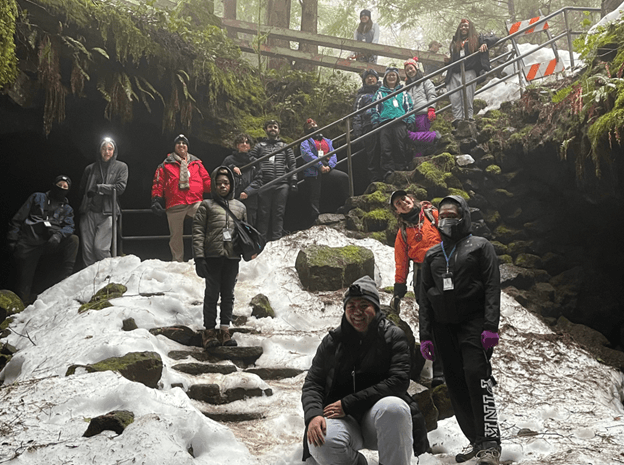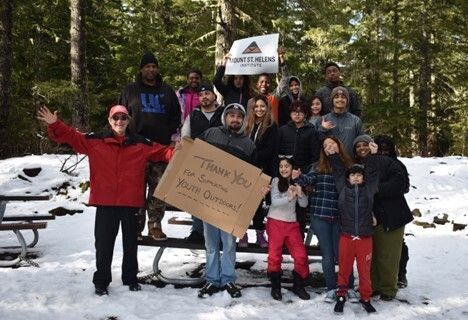By Gina Roberti, Science Education Coordinator, Mount St. Helens Institute

POIC Rosemary Anderson High school. Photo by Gina Roberti, MSHI staff.
As we round off the spring to autumn season of education programs at the Science & Learning Center, we begin to look forward to our winter snowshoe trips with youth groups! As a year-round member of the MSHI team, I’ve led youth snowshoe trips for the past several years and it is one of my favorite programs. As I look forward to the 2023 winter season, I reflect back on some of the joys of our past snowshoe outings.
We begin at the Trail of Two Forests parking lot, amidst an unassuming section of forest. The snow is several feet deep and covered with branches, lichen and other pieces of the forest canopy that have fallen in the weeks since the last fresh snow.
Who’s there? The majority of our trips are with youth, high school and middle school age. MSHI partners with nonprofits such as iUrban Teen, Unity Center, Latino Outdoors and Parenting with Intent, which engage youth from communities in Portland, Vancouver, and Longview/Kelso. Each organization seeks to connect youth from communities underrepresented in the outdoors with outdoor recreation experiences, education about natural history and information about science careers.
Since 2019, the Mount St. Helens Institute has worked to expand and increase opportunities for outdoor youth education programs in the winter season. We provide gear, information about the route, conditions, risk management, USFS special-use permit access into Ape Cave (closed to the public during the winter season), an interpretive educator, and volunteers for additional support.
Field trips to Mount St. Helens are memorable for so many reasons: in part, because volcanoes have stories to tell. In the landscape surrounding the ~8000’ Mount St. Helens, features such as the topography, soil, age and type of plants and the location of lakes are often clues telling stories of past eruptions. The stories echo themes of change, unpredictability, scale, resilience, surprise. These stories expand our understanding of natural phenomena and encourage us to reflect on our own relationship to change.
In the parking lot we circle to don our winter snowshoe attire. As a group, we share with each other tips for putting on snowshoes, adjusting poles, activating hand warmers and balancing on a snowbank. The group gathers warm layers, rolls up extra pairs of rain pants and fill their pockets with snacks.
We embark into the winter world, exploring off the trail and snow-covered road that leads up to Ape Cave. Signs of the lava flow beneath our feet are difficult to distinguish with the thick winter snowpack. We hike to see tree casts, the hollow openings in the ground formed when lava flowed (here, about ~2000 years ago) over a forest, burning and burying trees. They are filled with snow but yet are so clearly distinguished as former trees.

Latino Outdoors explores the winter ecology of the forest surrounding Ape Cave. Photo by Jared Stewart, MSHI staff.
We continue upstream, snowshoeing through the forest along the path of the lava flow and along the closed road to the entrance of Ape Cave. Our entire trip takes place atop the Cave Basalt lava flow, which flowed over seven miles from a vent on the southern flank of Mount St. Helens. Along the way, participants explore moss, lichen, plants and other life in the winter forest. The volcano is not visible except for a sliver of white between trees along the drive.

Youth with the iUrban teen group explore Ape Cave on a winter snowshoe trip with Mount St. Helens Institute. Photograph taken by Tavie Keo.
We descend the staircase and enter Ape Cave. Ape Cave is the longest continuous lava tube cave in the contiguous United States. To walk amidst such a large outpouring of basaltic lava is uncanny. This is a landscape in which magma must travel miles to reach the surface of the earth through layers and layers of crustal continental rocks rich in silica. Typically, this results in lava that is thick and viscous. Yet Ape Cave basalt lava flow was different - the lava that erupted on the surface was less viscous, and flowed, “runny like honey” down the flanks of Mount St. Helens, burning the forest and burying the land with a thick layer of dark black basaltic lava rock.

iUrban teen youth program in Ape Cave. Photo by Gina Roberti, MSHI staff.
In the past two years, the U.S. Forest Service has closed access to Ape Cave to the public during the winter. This is partly due to the fact that without ranger staff to encourage Leave No Trace practices, Ape Cave historically has been vandalized during the winter season. This makes for a unique experience on our winter snowshoe trips where Mount St. Helens Institute offers trips under a special use permit. Here, groups can experience the quiet of the cave without the crowdedness of public access. We turn off our lights inside and stand still, in the quiet. Senses heighten in the dark of the cave. One participant shares that it feels like being held inside the womb of the earth.
Upon breaking back into the natural light, a world of green and blues and warmth, the group shares a newfound appreciation for the way that sunlight filters through the trees. Our return journey is short, filled with conversations as our group finds more points of connection with each other. In the parking lot, we sip hot chocolate, reflect on the experience, and share gratitude. In an age where so many young people communicate through phones, it feels gratifying and grounding to have spent a few hours building relationships in person.
There is a power in the coming together of people, even amidst the pandemic, for a collective experience. The invitation to think more deeply about the land, and our connection to it, is refreshing. Together with the volunteers who supported our trip, we left feeling nourished.
And so, looking forward to our upcoming season, we invite you to spread the word and support a trip and other education programs. Review our informational slide deck about snowshoe programs and learn more about how to sign up for education programs. Please email me at learn@mshinstitute.org if you know of any youth organizations or school groups that would like to join us in the winter scape!

Unity Center youth group from Vancouver WA on a winter snowshoe trip with Mount St. Helens Institute. Photograph by Gina Roberti, MSHI staff.